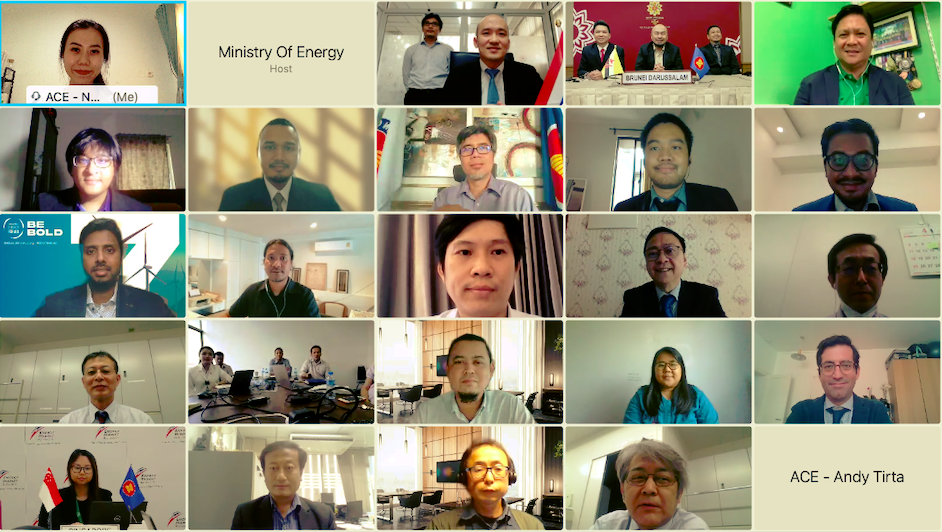Menu
Online, 7 April 2021The ASEAN Energy Efficiency and Conservation Sub- Sector Network (EE&C-SSN) convened their 25th Meeting to consider and agree on the status of the Energy Efficiency and Conservation (EE&C), Programme Area no. 4 under the ASEAN Plan of Action for Energy Cooperation (APAEC) Phase II, held virtually on 7 April 2021. The APAEC Phase II: 2021- 2025 was endorsed by the 38thASEAN Ministers on Energy Meeting (AMEM) last year.
 The importance of the Meeting was highlighted by Pengiran Haji Jamra Weira bin Pengiran Haji Petra, the SOE leader of Brunei Darussalam, as the host country. Mr. Jamra emphasised that, “in view of the growing concerns of climate change, as well as volatile energy prices, energy efficiency is regarded as one of the vital strategies for energy transition to support sustainable development.”
The importance of the Meeting was highlighted by Pengiran Haji Jamra Weira bin Pengiran Haji Petra, the SOE leader of Brunei Darussalam, as the host country. Mr. Jamra emphasised that, “in view of the growing concerns of climate change, as well as volatile energy prices, energy efficiency is regarded as one of the vital strategies for energy transition to support sustainable development.”
Reflecting the success of exceeding the 2020 energy intensity reduction target by achieving 21% in 2018 based on 2005 levels, APAEC Phase II sets a more ambitious energy intensity reduction target to 32% by 2025 based on 2005 level and expanding the EE&C initiatives to the industry and transportation sector.
To achieve this target, the EE&C- SSN and the ASEAN Centre for Energy (ACE) will focus on the five (5) outcome-based strategies (OBS) namely, (i) expanding, harmonising, and promote energy efficiency standards and labelling on energy-related products; (ii) enhancing private sector and financial institutions participation including Energy Service Companies (ESCOs) and Clusters for increased EE&C promotion; (iii) strengthening sustainability of energy efficiency in buildings; (iv) pursuing energy efficiency in the transport sector; and finally, (v) advancing energy efficiency and energy management in industry.
Dr. Nuki Agya Utama, the Executive Director of ACE, highlighted the importance of sharing resources and expertise between and among ASEAN Member States (AMS) in achieving energy transformation towards a more energy efficient and a low-carbon economy. He also encouraged ASEAN to further strengthen and deepen cooperation with and Dialogue Partners (DPs) and International Organisations (IOs). Dr. Utama also underscored the importance of developing a stronger triple-helix collaboration between Government, private sector, and academe for EE&C.
The Meeting also discussed the new and proposed EE&C projects and initiatives, including the Sustainable ASEAN Energy Management Certification Scheme, JAIF EE Financing Phase II, and EE market potentials, which was well received by the ASEAN Member States as they welcomed and encouraged the success of the proposed projects.
Noting how ASEAN needs to continue strengthening and deepening cooperation with DPs and IOs, further collaborations, and initiatives with new and existing DPs and IOs are crucial towards enhancing and implementing the EE&C programme under the APAEC Phase II in ASEAN.
“ASEAN Member States, DPs, and IOs, must collaborate to the best available abilities to achieve the target.”, said Dr. Pongpan Vorasayan, Senior Professional Engineer, Department of Alternative Energy Development and Efficiency, Ministry of Energy of Thailand as the Chair of EE&C-SSN.
Joining the annual meeting were representatives from ASEAN Secretariat, United Nations Environment Programme – United for Efficiency (UNEP-U4E), Energy Conservation Centre Japan (ECCJ), Korea Centre of Energy (KEA), Ministry of Economy, Trade, and Industry of Japan (METI), International Energy Agency (IEA), UNEP for the Global Fuel Economy Initiative, Sustainable Energy for All (SEforALL), and Asian Federation of Electric Vehicle Association (AFEVA). They expressed their strong support to the implementation of the APAEC Phase II.
Aside from discussing the progress of cooperation as well as the proposed initiatives under the APAEC Phase II, extensive appreciation were made for the IOs and DPs that have collaborated with ASEAN, andwelcomed new proposed cooperation activity plans and initiatives.
Moving forward, with the new sub-theme of “Accelerating Energy Transition and Strengthening Energy Resilience through Grater Innovation and Cooperation”, the Meeting noting the importance of maintaining the success achieved in APAEC Phase I, and to further continue and strengthen the cooperation in pursuing the new energy intensity reduction target through the implementation of APAEC Phase II and to move towards a transition for a more efficient energy utilisation.
(SEM)
By Shania Esmeralda Manaloe
